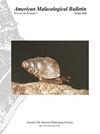鹦鹉螺pompilius Linnaeus的描述,1758年,来自摩鹿加群岛安汶的类型区和印度尼西亚松巴哇-龙目岛
IF 0.4
4区 生物学
Q4 MARINE & FRESHWATER BIOLOGY
引用次数: 5
摘要
摘要:1758年林奈鹦鹉螺(Nautilus Linnaeus, 1758)是分布最广的鹦鹉螺种,其分类学历史复杂,主要是由于1705年博物学家Rumphius (Rumpf)最早对其进行描述。他对其习性的描述和印度尼西亚摩鹿加群岛安汶岛标本的软解剖插图被林奈引用在他对庞皮留斯的描述中。然而,在印度尼西亚几乎没有关于鹦鹉螺的资料。在Ambon海域150-400米深度的活捕动物(n = 44)提供了来自模式区域的鹦鹉螺的第一个形态和遗传细节,包括最近提出的模式物种的新类型。另一个样本(n = 62)来自印度尼西亚松巴瓦-龙目岛地区,位于东南部1500公里处,与安汶岛的样本相同。这些种群拥有已知最大的成熟壳(平均直径约198毫米,壳加体重约1160克),是目前属于该物种的众多印度太平洋鹦鹉螺中最大的。除了大小之外,在其广阔的印度太平洋范围内,几乎没有主要的表型方面与其他种群不同。来自两个线粒体DNA基因区域的数据确定了一个强有力支持的进化支,包括Ambon、Sumbawa和菲律宾的N. pompilius s.s。这些新数据为评估广泛分布的N. pompilius s.l的遗传、表型和地理变异提供了基线,并为建立包括N. pompilius Linnaeus, 1758在内的现存鹦鹉螺种群的分类关系提供了基线。本文章由计算机程序翻译,如有差异,请以英文原文为准。
Descriptions of Nautilus pompilius Linnaeus, 1758 from the Type Area, Ambon, Molucca Islands, and from Sumbawa - Lombok Islands, Indonesia
Abstract: The taxonomic history of Nautilus pompilius Linnaeus, 1758, the most widely distributed species of Nautilus Linnaeus, 1758, is complex, mostly owing to the antiquity of the earliest description by the naturalist Rumphius (Rumpf) in 1705. His account of its habits and illustrations of soft anatomy of specimens from Ambon, Molucca Islands, Indonesia were cited by Linnaeus in his description of N. pompilius. Nevertheless, there is almost no information on Nautilus in Indonesia. Live-caught animals (n = 44) from 150–400 m depth off Ambon provide the first morphologic and genetic details on Nautilus pompilius from the type region, including a recently proposed neotype for the type species. An additional sample (n = 62) obtained from the Sumbawa-Lombok Islands area, Indonesia, 1,500km to the southeast appears identical to those from Ambon. These populations have the largest known mature shells (mean ∼198mm diameter, ∼1,160 g shell plus body weight) of any of the numerous Indo-Pacific occurrences of Nautilus pompilius s.l. presently assigned to this species. Aside from size, few major phenotypic aspects differ from other populations of the species throughout its broad Indo-Pacific range. Data from two mitochondrial DNA gene regions identified a strongly supported clade comprising Ambon, Sumbawa, and Philippines N. pompilius s.s. These new data provide a baseline for evaluating genetic, phenotypic and geographic variation in the broadly distributed species N. pompilius s.l., as well as for establishing taxonomic relationships in populations of living Nautilus, including N. pompilius pompilius Linnaeus, 1758.
求助全文
通过发布文献求助,成功后即可免费获取论文全文。
去求助
来源期刊
CiteScore
1.00
自引率
40.00%
发文量
1
审稿时长
>12 weeks
期刊介绍:
The American Malacological Bulletin serves as an outlet for reporting notable contributions in malacological research. Manuscripts concerning any aspect of original, unpublished research,important short reports, and detailed reviews dealing with molluscs will be considered for publication. Recent issues have included AMS symposia, independent papers, research notes,and book reviews. All published research articles in this journal have undergone rigorous peer review, based on initial editor screening and anonymous reviewing by independent expertreferees. AMS symposium papers have undergone peer review by symposium organizer, symposium participants, and independent referees.

 求助内容:
求助内容: 应助结果提醒方式:
应助结果提醒方式:


